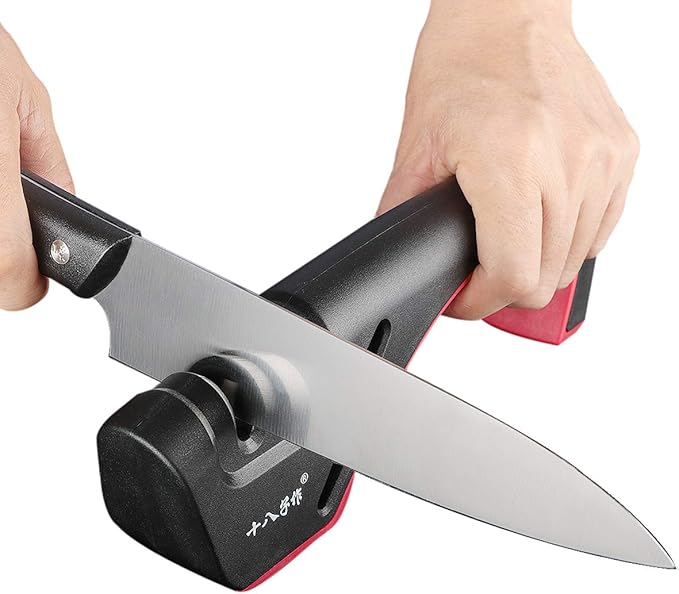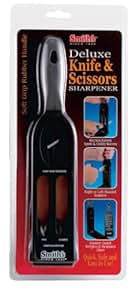Dull knives are a menace in the kitchen. They’re dangerous, inefficient, and frankly, frustrating. But before you rush out to buy a fancy electric sharpener (which can be quite pricey!), consider the world of DIY knife sharpening. With a little ingenuity and some readily available materials, you can create your own effective knife sharpener, saving money and gaining a satisfying sense of accomplishment.
Why DIY?

There are several compelling reasons to make your own knife sharpener. First, it’s significantly cheaper than buying a pre-made one. Second, you gain a deeper understanding of knife sharpening techniques. This knowledge empowers you to adapt your sharpening method to different knife types and levels of dullness. Finally, creating a DIY sharpener can be a fun and rewarding project, allowing you to customize it to your specific needs and preferences.
Simple Sharpening Stones: The Foundation of DIY Sharpening

The most basic, and arguably most effective, DIY knife sharpener is a simple sharpening stone. These are readily available online and at hardware stores. You’ll need to choose the right grit for your needs – coarser grits (e.g., 100-200 grit) are used for initial sharpening or heavily damaged blades, while finer grits (e.g., 1000-8000 grit) are for honing and achieving a razor-sharp edge.
Using Sharpening Stones: Start by soaking the stone in water for about 15-20 minutes to soften it and prevent clogging. Then, hold the knife at a consistent angle (typically around 20 degrees, but this varies by knife type) and gently draw the blade across the stone, using even pressure. Repeat this process on both sides of the blade, alternating between the coarse and fine stones as needed. Proper technique and patience are crucial here – rushing will lead to uneven sharpening or damaged blades. Plenty of online tutorials offer detailed guidance on proper sharpening stone technique.
The Improvised Sharpening Steel
While not a true sharpener, a sharpening steel can maintain the edge of your knives between sharpening sessions. You can even improvise your own using a sturdy, smooth rod of metal. An old file (carefully cleaned and smoothed down), a sturdy metal dowel, or even a long, appropriately shaped bolt can serve as a basis. Remember, the goal isn’t to sharpen, but to straighten the edge. Use a consistent angle and sweeping motion, carefully sliding the blade down the length of the steel.
Caution: Using an improvised steel requires extra care. Improper use can damage your knife. Ensure the metal is smooth and free of burrs or sharp edges before using it.
The Bottle Sharpener: A Budget-Friendly Option
For a truly low-cost option, consider a bottle sharpener. This involves attaching a piece of sandpaper (medium-to-fine grit) to a cylindrical object like a wine bottle or a sturdy metal pipe. Secure the sandpaper tightly, ensuring it’s smooth and wrinkle-free. Then, carefully draw the blade across the sandpaper-covered surface, maintaining a consistent angle. This is a good method for quick touch-ups but might not be suitable for significantly dull knives.
Advanced DIY Sharpeners: Harnessing the Power of Angles
More ambitious DIYers might consider building a jig or guide to help maintain a consistent angle during sharpening. This is especially useful when using sharpening stones, ensuring uniform sharpening across the blade’s entire length. Such jigs can be made from wood, acrylic, or even metal, using simple tools and readily available materials. Online resources offer detailed plans and instructions for building various sharpening jigs.
Maintaining Your DIY Sharpener

Regardless of which DIY sharpener you choose, proper maintenance is crucial. Sharpening stones should be cleaned after each use to remove metal particles. Improvised sharpening steels should be checked for damage and smoothed if necessary. Sandpaper on bottle sharpeners should be replaced when it becomes worn or clogged.
Beyond the Basics: Adding Refinement

Once you’ve mastered the basics, consider adding refinements to your DIY setup. A magnifying glass can help you better inspect the blade’s edge, and a sharpening lubricant (like honing oil) can make the sharpening process smoother and prevent the stone from clogging. Invest in a selection of sharpening stones with various grits to handle different sharpening needs. With experience and experimentation, your homemade sharpening skills will continuously improve, leading to perfectly honed knives and safer kitchen practices.
Remember, safety should always be your priority when working with sharp knives and potentially sharp DIY tools. Always use caution and proceed carefully. With patience and practice, you can achieve amazing results and transform your dull knives into precision cutting instruments.